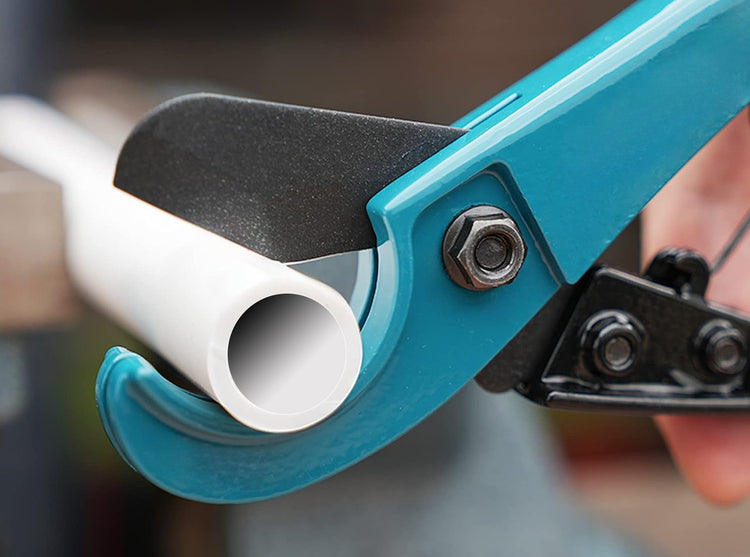We discuss the seven best ways to cut PVC pipes and rank them based on their ease of use (effort), precision (clean cut), and efficiency (cost).
Cutting PVC pipe is an essential step in any PVC project and often represents the most time-consuming phase. The age-old adage "measure twice, cut once" remains ever pertinent. Proper measurement can save you from waste and potential mistakes. However, once you've got the measurements right, how should you cut the pipe to ensure ease, accuracy, and efficiency? Below, we delve into the seven top methods for cutting PVC pipes, based on their ease of use (effort), precision (clean cut), and efficiency (cost).
You can learn more about these methods and other ways to cut PVC pipe by viewing our FORMUFIT PVC Cutting Guide, which is freely available along with all of our other guides at formufit.com/guides.
Handsaw
Other names: Wood Saw, Rip saw, Crosscut saw
Rating: ⭐
Recommendation: It works. If you want rough cut with a lot of cleanup.

A handsaw is a versatile cutting tool usually used to cut wood, but in a pinch, can be used to cut PVC pipes. However, this type of saw will not provide the cleanest or most accurate cuts and can be frustrating as they are not very rigid and tend to wobble as you get deeper into the pipe. This lack of a clean cut is because a typical handsaw has teeth farther apart and tears at the walls of the PVC pipe. It’s also harder to or change the direction you’re going down the pipe and therefore far less accurate to create good 90-degree cuts. Like using a hacksaw, secure the pipe in a vise or clamp and saw through the material with a back-and-forth motion.
Pros:
- Inexpensive
- Can handle pretty much any PVC pipe size
- Most people have one in their toolbox (if they don't have a hacksaw)
Cons:
- Requires more effort than other methods
- Will leave rough edges and burrs
- Less precise compared to other saws
String or Wire
Other names: PVC Cable Saw, Wire Saw, Plumbers Wire Saw, Rope Saw
Rating: ⭐⭐
Recommendation: Great for tight spaces, but that's about it.

Using a string or wire to cut PVC pipe is a simple, low-tech method that can be surprisingly effective, especially in tight spaces, or in cases where your project is already built and you need to make adjustments like adding another fitting or two to add support. To cut a pipe with a string or wire, wrap the string or wire around the line, cross the ends, and then pull the string back and forth in a sawing motion to cut through the pipe. It takes some time, but it can be far more accessible than positioning everything just right to get a hacksaw in the right spot.
Pros:
- Inexpensive
- Can be used in tight spaces
- No special tools are required
Cons:
- Requires more effort than other methods
- Takes time to complete
- Can leave rough edges or burrs
Plastic Tube Pipe Cutter
Other names: Tubing cutter, Flexible Tube Cutter, pipe cutter
Rating: ⭐⭐⭐
Recommendation: Works well for small pipe diameters, but takes a lot of effort.

A Plastic Tube pipe cutter is a clamp-style cutter with a straight, sharp blade that functions similarly to a ratcheting pipe cutter, but the cutting action is done in a rotational method rather than directly through the pipe. This method only works well for small-diameter pipes, such as 1/2" or 3/4", as larger diameters can be cumbersome. Once your measurement is marked, open the jaws of the tube cutter and place the PVC pipe between them, aligning the cutting blade with the mark on the pipe. Squeeze the cutter's handles together on the mark, then rotate the cutter around the pipe, making sure to stay in a straight line. Continue to apply pressure by squeezing the handles and turning more, gradually cutting through the pipe walls until the segment is separated.
Pros:
- Good speed of cutting
- Easy to use
- Polished, clean edge with zero burrs
- Only ideal for small-diameter pipe (1/2" to 3/4")
- Some cutters are cheap plastic and can break
- You may need to sharpen or replace the blade frequently
- Regular use will cause hand strain
Power Miter Saw
Other Names: Chop Saw, Compound Miter Saw, Drop Saw
Rating: ⭐⭐⭐
Recommendation: The best solution for large quantities of pipe cuts

A power miter saw is an excellent choice for making many clean, straight cuts in PVC pipes. These power tools have a circular saw blade that can easily cut through PVC pipes. For this power miter saw PVC pipe-cutting method, mark your cutting line on the pipe, line up the saw blade with the mark, and secure it using clamps against the miter saw fence. Next, turn on the saw and lower the blade to cut through the pipe. Be sure to allow the blade to stop spinning before lifting the blade back up. While there should be no burrs on the pipe edge, it will leave behind pipe residue that can be messy, and the edge of the pipe will not be completely smooth.
Pros:
- Fast cutting of a large quantity of pipe
- Straight, clean cuts
- Can handle larger diameter pipes
Cons:
- Requires access to or the purchase of a power tool
- Can be dangerous if not used properly
- Still messy as pipe debris will be left behind
Ratcheting PVC Pipe Cutter
Other Names: Ratchet pipe cutter; ratchet cutter, PVC shears
Rating: ⭐⭐⭐⭐
Recommendation: Perfect clean cuts, but tough on your hands.

A ratcheting PVC pipe cutter is the top choice for most users due to its ease of use and clean cuts. A ratcheting pipe cutter is a specialized handheld tool with a sharp blade and a ratcheting mechanism that applies controlled pressure to cut the pipe gradually. To use a ratchet pipe cutter, position the pipe in the cutting groove and squeeze the handles repeatedly to use this cutter. The ratchet mechanism will incrementally tighten the blade, separating the plastic and resulting in a clean, burr-free cut. The only downside to this tool is that you must cut perfectly straight with a nicely sharpened blade to avoid an angled cut that may not allow for a perfect 90-degree cut. Also, the larger the pipe diameter, the harder it can be to use a ratcheting pipe cutter. Finally, repeated use of this tool will cause strain in the hands to exhaustion. Take frequent breaks when cutting via this method, or choose another way if doing a large volume of cuts.
Pros:
- Fast cutting
- Easy to use
- Polished, clean edge with zero burrs
Cons:
- Not be suitable for larger diameter pipes
- Some cutters can be an expensive, one-time purchase
- You may need to sharpen or replace the blade frequently
- Regular use with cause hand strain
Power PVC Shears
Other names: Cordless PVC Cutter; Cordless PVC Shear
Rating: ⭐⭐⭐⭐⭐
Recommendation: Perfect clean cuts without the hand strain.

While it has a significant upfront investment, a set of Cordless PVC Shears is a super efficient and quick way to cut PVC pipe and has become more commonplace. These electric shears work just like most PVC pipe cutters; a curved groove to place your pipe into and a single blade that physically cuts the plastic pipe, guillotine style. To cut with these shears, ensure the battery is charged and inserted, then mark your pipe where you want the cut, and finally, set the pipe into the cutter at the mark and push the button until it cuts completely. This solution is as effective as a power miter saw but far safer and less intimidating. The only drawback is getting perfectly straight cuts that are 90 degrees vertical; like other handheld PVC cutters, the blade tends to drift during the process, creating a cut that could be a better right angle.
Pros:
- Fast cutting with zero hand strain
- Battery-operated and portable
- Polished, clean edge with zero burrs
- Works with most pipe sizes, 1/2" to 2"
Cons:
- Can be an expensive, one-time purchase, not including the battery
- You may need to sharpen or replace the blade frequently
- May not cut perfect 90-degree cuts
Hacksaw
Other names: Hack Saw, PVC Saw; Japanese saw
Rating: ⭐⭐⭐⭐⭐
Recommendation: The Tried and True Solution.

The hacksaw is the most popular manual cutting tool for PVC pipe, especially for those who want to avoid investing in specialized tools. Most people already have one in their basement or garage. A hacksaw consists of a metal frame that holds a fine-toothed blade. To cut a PVC pipe with a hacksaw, secure the pipe in a vise or clamp, then use a back-and-forth motion to cut through the material. This method of cutting PVC pipe can be messy. It will create burrs on the pipe's inner diameter edge that the person cutting the pipe should remove with a dull edge, such as a kitchen knife or a burr remover, but overall it's the cheapest and most effective method to cut pipe.
Pros:
- Affordable
- Readily available
- Can handle almost any pipe size
- Works well for larger quantities of cuts
Cons:
- Requires more effort compared to specialized tools
- May leave rough edges or burrs
- It will leave a mess
In conclusion, the best method largely depends on the specific requirements of your project. While a ratcheting PVC cutter is an excellent all-rounder for many, a simple hacksaw might be sufficient for smaller tasks. Weigh the pros and cons of each based on your project size, budget, and the tools you already have at your disposal. Always prioritize safety, regardless of the method chosen.
There are more ways than just the methods listed above to cut PVC pipe down to size. For more information regarding cutting and the other methods of cutting PVC pipe, please see our PVC Pipe and Fittings Guides, available in our PVC Guides section of our site.


